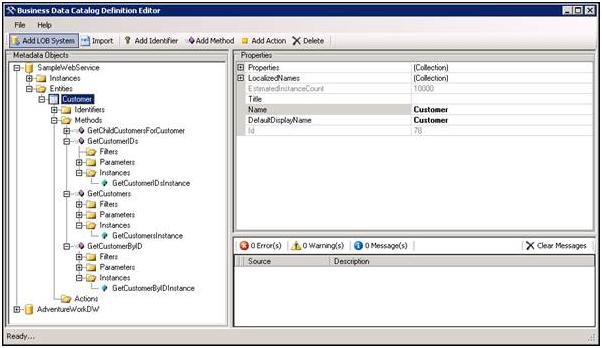Microsoft Business Data Catalog Definition Editor
Summary:
The Microsoft Business Data Catalog Definition Editor is available in the recent release of the MOSS2007 SDK 1.2
Overview:
The Business Data Catalog Definition Editor provides a visual tool for creating an Application Definition for the BDC in MOSS 2007. Features include:
- Underlying XML is abstracted by the design surface and properties window
- Drag and drop web methods, tables, or views to create line of business (LOB) connections.
- Entities and methods are created automatically from database metadata and WSDLs.
- Additional method instances can be added to further enhance the DB or WS connection.
- Method instances can be tested from within the tool, enabling incremental development of LOB connections

Background:
Currently, writing an application definition to connect the BDC to a LOB system is a manual process. This requires an understanding of both how the LOB system is configured and what must be included in the XML to satisfy the BDC. Having a tool to simplify this process not only lowers the initial knowledge threshold for administering the BDC, it also lessens the required work of the user (such as testing, making modifications, etc.).
The tool has been designed to assist in the lifecycle management for Application Definition files. The tool enables searching over databases and web service-based repositories, as well as the connection for BDC web parts in MOSS.
Highlights:
- Tool supports Databases (SQL, Oracle, OLEDB, and ODBC) and Web Services
- Drag and drop design surface for selecting DB tables or web methods
- Metadata is automatically extracted from Databases by dragging and dropping tables
- Web Services require a few additional steps to completely configure the connection
- Users can import and export Application Definition XML files
- Users are able to test method instances incrementally from within the tool
- The tool is not required to run on a Web Front-End
- Associations are created automatically when foreign keys are selected; they can also be created easily for web services by adding an Association method instance
Comments
- Anonymous
May 29, 2009
PingBack from http://paidsurveyshub.info/story.php?title=micha-morciniec-microsoft-business-data-catalog-definition-editor